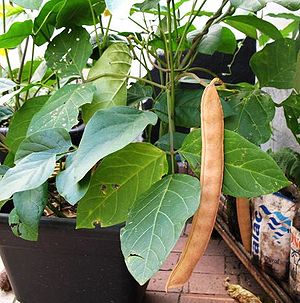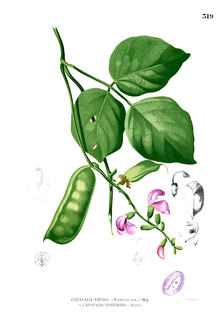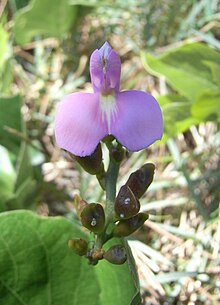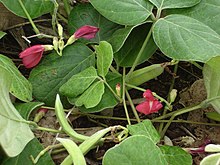Canavalia
| Canavalia | ||||||||||||
|---|---|---|---|---|---|---|---|---|---|---|---|---|

Jack bean ( Canavalia ensiformis ) |
||||||||||||
| Systematics | ||||||||||||
|
||||||||||||
| Scientific name | ||||||||||||
| Canavalia | ||||||||||||
| Adans. |
Canavalia is a genus in the subfamily Schmetterlingsblütler (Faboideae) within the family of the Leguminosae (Fabaceae). The 46 to 51 Canavalia species are distributed almost worldwide from the subtropics to the tropics. It is one of the genera of the Faboideae, the species of which arecalled beans and are used as food.
Description and ecology


Appearance and leaves
Canavalia species grow as creeping or climbing, independently upright, perennial herbaceous plants , or woody plants: shrubs or lianas; they can be evergreen or deciduous. Resin may be present. They are not armed with spikes or thorns. The climbing species wind their way up counterclockwise. Some species develop tubers .
The arranged and alternate spiral or two lines is distributed on stem leaves are stalked, herbaceous or leathery, and usually feathered unpaired. There are three 4 to 15 cm long pinna flake present, the leaves are therefore three parts. The flat leaflets are entire and flat. The two persistent or early falling stipules are free from each other and not fused with the petiole, sometimes they are only tiny and scale-shaped.
Inflorescences and flowers
The flowers stand in pairs to six in clusters on the swollen nodes of the lateral, compound, clustered inflorescences . There are bracts and small bracts that fall off early.
The stalked, hermaphrodite flowers are zygomorphic and five-fold with a double flower envelope . The five unequal sepals are fused with two sepal lips, the sepals are at most as long as the upright calyx tube. The upper calyx lip consists of two partially fused, longer calyx lobes; the lower calyx lip consists of three shorter calyx lobes. The flower crowns have the typical structure of the butterfly flowers. There are five petals that can be nailed; the two lower petals have grown together to form a boat, in some species two more have grown together. The colors of the petals range from pink to purple. The normally developed flag is not spurred but eyed at the base and has appendages. The two wings are not fused with the shuttle and have no spur. The shuttle also has no spur and is typically designed; some species have an inwardly turned beak. The ten fertile stamens are not fused with the petals and significantly longer ones alternate with shorter ones. Of the ten fertile stamens, all or nine of the stamens are fused into a tube, but not fused with the petals. There are nectar glands on the disc. The individual upper carpels contain two to 15 ovules . The curved style is hairy but not bearded, with a small scar. Sometimes a gynophore is trained. Pollination takes place via insects, mainly Hymenoptera ( entomophilia ).
Fruits and seeds
The straight to curved legumes are 7 to 22 cm long. The legumes are not septate between the seeds and more or less or not constricted. Each fruit contains four to 15 seeds. The non-angular seeds can have an aril . The unit of spread ( diaspore ) is the seed.
use
Some species are cultivated for the production of food:
- Jack bean ( Canavalia ensiformis (L.) DC. )
- Sword bean ( Canavalia gladiata (Jacq.) DC. )
Since they fix nitrogen ( Rhizobium root nodules ), they are important for soil improvement.
In Mexico in particular, the beach bean or sea bean ( Canavalia rosea (Sw.) DC., Syn .: Canavalia maritima Thouars) is used as a hallucinogen (active ingredient: L- betonicin ); sometimes part of the drug " Spice ".

Systematics and distribution
The genus Canavalia belongs to the subtribe Diocleinae of the tribe Phaseoleae in the subfamily of butterflies (Faboideae) within the family of legumes (Fabaceae). The genus was first published in 1763 by Michel Adanson as Canavali in Familles des plantes , 2, p. 325, 531 - today valid (ICBN, 1983, No. 3891) is the spelling Canavalia , which was published in 1825 by Augustin-Pyrame de Candolle in Prodromus systematis naturalis regni vegetabilis , 2, p. 403. The generic name Canavalia is derived from the common name of the species Canavalia ensiformis used on the Malabar coast : “kanna-valli” directly translated as “forest climber”. Many species used to belong to the genus Dolichos L. Synonyms for Canavalia Adans. are Clementea Cav. , Cryptophaeseolus Kuntze and Wenderothia Schltdl.
The genus Canavalia has a wide distribution area; there are species in the tropics and subtropics worldwide.
There are 46 to 51 Canavalia species (selection):
- Canavalia acuminata Rose : It is common in Mexico .
- Canavalia africana Dunn (Syn .: Canavalia ferruginea Piper , Canavalia virosa auct.): It occurs in Africa , on Socotra and in India .
- Canavalia altipendula (Piper) Standl. : It occurs in the Caribbean.
- Canavalia aurita J.D.Sauer : The home is Indonesia .
- Canavalia bicarinata Standl. : It is common in Central America and northern South America .
- Canavalia boliviana Piper : The home is Bolivia and Peru .
- Canavalia bonariensis Lindl. : It occurs in South Africa, Reunion, Brazil, Argentina and Uruguay.
- Canavalia brasiliensis Mart. ex Benth. (Syn .: Canavalia anomala Piper , Canavalia caribaea Urb. , Canavalia fendleri Piper , Canavalia leptophylla Piper , Canavalia mexicana Piper , Canavalia panamensis Piper , Canavalia paraguayensis Piper , Canavalia prolifica Piper ex Ricker ): It is from Florida via Mexico and central to Widespread in South America and the Caribbean islands.
- Canavalia campylocarpa Piper (Syn .: Canavalia dictyota Piper ): It is distributed on the Caribbean islands and from Central to South America.
- Canavalia cathartica Thouars (Syn .: Canavalia microcarpa (DC.) Piper , Canavalia turgida Graham ex A.Gray , Canavalia virosa (Roxb.) Wight & Arn. , Dolichos virosus Roxb. , Lablab microcarpus DC. ): It occurs in Eastern Africa , in Asia, in Queensland and on islands in the Pacific.
- Canavalia centralis St.John : It is common in the USA.
- Canavalia concinna J.D.Sauer : It is common in Brazil.
- Canavalia dictyota Piper : It occurs in the USA, on the Caribbean islands, in Panama and in South America.
- Canavalia dolichothyrsa G.P. Lewis : It is common in Brazil.
- Canavalia dura J.D.Sauer : It is common in Mexico.
- Jack bean or Madagascar bean ( Canavalia ensiformis (L.) DC. ): It is found in Africa, Asia, Australia, the New World, the Caribbean islands, and islands in the Indian Ocean and Pacific.
- Canavalia eurycarpa Piper : It is common in Peru, Bolivia and Brazil.
- Canavalia favieri I.C.Nielsen : It comes in Caledonia before.
- Canavalia forbesii St.John : The home is the USA.
- Canavalia galeata (Gaudich.) Vogel (Syn .: Dolichos galeatus Gaudich. ): It occurs only in Hawaii.
- Canavalia glabra (M.Martens & Galeotti) JDSauer : It is widespread from Mexico via Guatemala, Honduras to Panama and from Colombia and Bolivia to Peru.
- Sword bean ( Canavalia gladiata (Jacq.) DC. ) (Syn .: Dolichos gladiatus Jacq. ): It occurs in Africa, Asia, Australia, the New World, the Caribbean Islands, New Guinea, Hawaii and the islands in the Indian Ocean in front.
- Canavalia grandiflora Benth. : It is common in Brazil and Peru.
- Canavalia haleakalaensis St.John : It occurs in Hawaii.
- Canavalia hawaiiensis Degener & al. : It only occurs in Hawaii.
- Canavalia hirsutissima J.D.Sauer : It is distributed from Mexico via Guatemala to El Salvador.
- Canavalia iaoensis St. John : It occurs in Hawaii.
- Canavalia kauaiensis J.D.Sauer : The home is Hawaii.
- Canavalia kauensis St.John : The home is Hawaii.
- Canavalia lineata (Thunb.) DC. (Syn .: Dolichos lineatus Thunb. ): It occurs in the Philippines, Indochina, China and East Asia.
- Canavalia macrobotrys Merr. (Syn .: Canavalia luzonica Piper ): It occurs on Celebes and in the Philippines.
- Canavalia macropleura Piper : It occurs in Venezuela.
- Canavalia madagascariensis J.D.Sauer : Your home is Madagascar.
- Canavalia makahaensis St.John : It occurs in Hawaii.
- Canavalia mattogrossensis (Barb.Rodr.) Malme (Syn .: Mucuna mattegrossensis Barb.Rodr. , Wenderothia mattogrossensis (Barb.Rodr.) Piper ): It is common in South America.
- Canavalia matudae J.D.Sauer : It is distributed from Mexico to Guatemala.
- Canavalia megalantha Merr. : It only occurs in Guam and the northern Mariana Islands.
- Canavalia microsperma Urb. : It only occurs in Cuba.
- Canavalia mollis Wight & Arn. : It occurs from India, Sri Lanka and Indonesia to Timor.
- Canavalia molokaiensis O.Deg. et al. : It only occurs in Hawaii ( Moloka'i ).
- Canavalia munroi (Degener & Degener) St.John : The home is Hawaii.
- Canavalia napaliensis H.St.John : It occurs only in Hawaii ( Kaua'i ).
- Canavalia nitida (Cav.) Piper (Syn .: Canavalia rusiosperma Urb. , Clementea nitida Cav. ): It occurs on the Caribbean islands of the Bahamas, the Cayman Islands , Cuba, Hispaniola , Puerto Rico and the Virgin Islands.
- Canavalia nualoloensis St.John : It occurs in Hawaii.
- Canavalia obidensis Ducke : It is common in Brazil.
- Canavalia oxyphylla Standl. & LOWilliams : It is distributed from Central America to northern South America.
- Canavalia palmeri (Piper) Standl. : It is common in Mexico.
- Canavalia papuana Merr. & LMPerry : It occurs from Indonesia and New Guinea to Australia and the Bismarck Archipelago.
- Canavalia plagiosperma Piper : It occurs in Guinea-Bissau, in Costa Rica, Guayana, Peru and on the Caribbean islands.
- Beach bean , sea bean or MacKenzie bean ( Canavalia rosea (Sw.) DC. , Syn .: Canavalia maritima Thouars , Canavalia obtusifolia DC. , Dolichos maritimus Aubl. , Dolichos obtusifolius Lam. , Dolichos roseus Sw. ): It is in Africa, Asia, Widespread in Australia, the New World, and islands in the Pacific.
- Canavalia sericea A.Gray : It occurs in the Fiji Islands.
- Canavalia veillonii I.C. Nielsen : It was first described from New Caledonia in 2004.
- Canavalia villosa Benth. : It is common in the Neotropics from Mexico to Ecuador.
No longer belongs to the genus:
- Canavalia grandis (Wall. Ex Benth.) Short → Dysolobium grande (Wall. Ex Benth.) Prain
See also
swell
- SI Ali: Papilionaceae. : Canavalia at Tropicos.org. In: Flora of Pakistan . Missouri Botanical Garden, St. Louis
- Leslie Watson: Papilionaceae in the Western Australian Flora , 2008: Canavalia - Online.
- C. Gardner: Fabaceae in the New South Wales Flora Online : Canavalia - Online.
- G. Lewis et al .: Legumes of the world. (Leg World), 2005, 396.
Individual evidence
- ^ Canavalia maritima .
- ↑ Information on "Spice".
- ^ SI Ali: Papilionaceae. : Canavalia at Tropicos.org. In: Flora of Pakistan . Missouri Botanical Garden, St. Louis
- ^ A b Canavalia in the Germplasm Resources Information Network (GRIN), USDA , ARS , National Genetic Resources Program. National Germplasm Resources Laboratory, Beltsville, Maryland.
- ↑ a b c d e f g h i j k l m n o p q r s t u v w x y z aa from ac ad ae af ag ah ai generic names in the search at Ildis = & International Legume Database Information Service enter .
- ↑ Data sheet ( Memento of the original from October 18, 2008 in the Internet Archive ) Info: The archive link was inserted automatically and has not yet been checked. Please check the original and archive link according to the instructions and then remove this notice. at tropicalforages .
- ↑ a b Ivan C. Nielsen: A new inland species of Canavalia (Leguminosae, Papilionoideae) from New Caledonia. in Adansonia , Sér. 3, 26, 2, 2004, pp. 149-151: Online. ( Memento of the original from August 8, 2011 in the Internet Archive ) Info: The archive link was inserted automatically and has not yet been checked. Please check the original and archive link according to the instructions and then remove this notice. (PDF; 669 kB)








